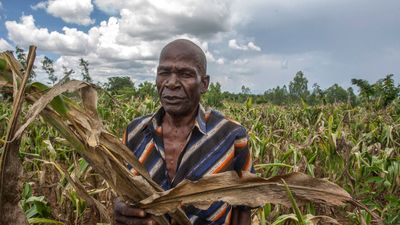There's a Drought Crisis in Southern Africa; Here’s How to Help
Malawi has declared a “State of Disaster” as countries in the Southern African Development Community deal with serious drought brought on by climate change.
Update: This story has been updated with the latest developments as of Monday, March 25, 2024 at 20:30 GMT.
Malawi president, Lazarus Chakwera, has declared a state of disaster due to serious drought in 23 of its 28 districts. Chakwera made the announcement after touring the country, stating that 44% of corn crops had failed and 2 million households were directly affected.
In recent times, Malawi has been hit by extreme weather conditions. Last year, Cyclone Freddy killed hundreds after lasting a record 38 days. Only just recovering from that devastating event, the country of over 20 million people needs about $200 million in humanitarian aid amidst this widespread drought, according to Chakwera.
Southern Africa is in the midst of another drought crisis. For years, the region has been hit by the effects of climate change on an extreme level, dealing with irregular rainfall and witnessing El Niño events, where the sea surface temperature is much warmer than usual.
Between 2018 and 2021, Angola, Zimbabwe, Mozambique, South Africa and several other countries that make up the Southern African Development Community (SADC) suffered through a meteorological drought. With less than average rainfall in those years, especially during the wet season, typically November to March, food security took a hit and it deeply affected the lives and livelihoods of many.
During that period, thousands of Zimbabweans slept in water lines, while about 1.3 million Angolans were driven to high levels of acute food insecurity. The effects of the drought were also worsened by the coronavirus pandemic. When the crisis subsided in early 2022, after an above average rainfall period in the wet season, it wasn’t expected that there would be a drought cisis so soon. But that is the case now.
In late February, Zambian president Hakainde Hichilema declared that the country was going through a national disaster, due to a severe lack of rain that’s greatly limiting the agricultural sector and affecting over a million households. The lack of rain is also expected to lead to a serious power deficit, which is significant as Zambia produces most of its electricity through hydropower.
In Zimbabwe, the government is contemplating declaring a state of emergency due to the drought, as agricultural production has taken a massive hit. “When you drive around, you will see that many crops have wilted,” World Food Programme acting country director Christine Mendes said while in Buhera, 140 miles away from the capital city, Harare.
In South Africa’s biggest city, Johannesburg, public taps aren’t dispensing water regularly, a situation that’s been attributed to an ongoing heatwave, “as well as reservoirs being critically low to empty,” according to public services provider Johannesburg Water. With the wet season supposed to be ending in a few days, rainfall is needed to improve the country’s water reservoir levels.
Across the member countries of the SADC, the drought’s effects are already evident, and it’s hoped that it isn’t on the same level as the humanitarian crisis from the previous drought.
For those that can, here are a few ways to help:
You can donate to UNICEF Eastern and Southern Africa, in their efforts to offer health and humanitarian aid to the most vulnerable children in the region.
You can donate to World Vision’s Southern Africa Hunger Emergency Response initiative, aimed at offering humanitarian assistance to those who are experiencing the negative effects of the climate crisis.
You can donate to World Food Programme Southern Africa, as they drum up awareness for what’s happening across the region.
